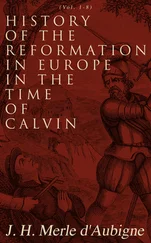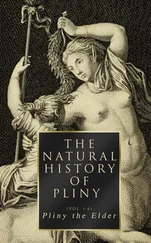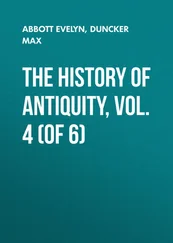Evelyn Abbott - The History of Antiquity, Vol. 3 (of 6)
Здесь есть возможность читать онлайн «Evelyn Abbott - The History of Antiquity, Vol. 3 (of 6)» — ознакомительный отрывок электронной книги совершенно бесплатно, а после прочтения отрывка купить полную версию. В некоторых случаях можно слушать аудио, скачать через торрент в формате fb2 и присутствует краткое содержание. Жанр: foreign_antique, foreign_prose, Историческая проза, на английском языке. Описание произведения, (предисловие) а так же отзывы посетителей доступны на портале библиотеки ЛибКат.
- Название:The History of Antiquity, Vol. 3 (of 6)
- Автор:
- Жанр:
- Год:неизвестен
- ISBN:нет данных
- Рейтинг книги:5 / 5. Голосов: 1
-
Избранное:Добавить в избранное
- Отзывы:
-
Ваша оценка:
- 100
- 1
- 2
- 3
- 4
- 5
The History of Antiquity, Vol. 3 (of 6): краткое содержание, описание и аннотация
Предлагаем к чтению аннотацию, описание, краткое содержание или предисловие (зависит от того, что написал сам автор книги «The History of Antiquity, Vol. 3 (of 6)»). Если вы не нашли необходимую информацию о книге — напишите в комментариях, мы постараемся отыскать её.
The History of Antiquity, Vol. 3 (of 6) — читать онлайн ознакомительный отрывок
Ниже представлен текст книги, разбитый по страницам. Система сохранения места последней прочитанной страницы, позволяет с удобством читать онлайн бесплатно книгу «The History of Antiquity, Vol. 3 (of 6)», без необходимости каждый раз заново искать на чём Вы остановились. Поставьте закладку, и сможете в любой момент перейти на страницу, на которой закончили чтение.
Интервал:
Закладка:
CHAPTER III.
THE PHARAOHS OF TANIS, BUBASTIS, AND NAPATA
At the close of the fourteenth century B.C. Ramses III. had secured Egypt against the attacks of the Libyans, Syrians, and Arabians. His successors of the same name remained peacefully within the borders of their land. Neither tradition nor monuments tell us of their campaigns. Two or three sepulchres in the rocks of Biban el Moluk and some inscriptions give us their names, and inform us that these Ramessids built at the temple of Chon at Thebes, that they maintained the dominion of Thebes up the Nile as far as Mt. Barkal down to the year 1100 B.C. 127Of more importance is the fact that under the successors of Ramses VI., the last rulers of the name of Ramses, who sat on the throne from the year 1200 to 1074 B.C., the high-priests of Thebes obtained a position which formed a strong counterpoise to the power of the kings, and at length threw it into the back-ground, if it did not altogether remove it. In inscriptions in the temple of Chon, Herhor, the high-priest at the time of Ramses XIII., receives the title of prince ( si suten , king's son) of Cush, a title borne by the viceroys of Napata since Ramses II. They call him "Commander-in-chief of the army in Upper and Lower Egypt;" and finally, "Si-Amun" and "Si-Ra," and with these titles, which were borne by the Pharaohs, Herhor receives also the symbols of the king. It is also thought that the inscriptions speak of tribute of the Retennu, i. e. the Syrians, which he received. 128It may be that Herhor rose to the throne after the death of Ramses XIII., or that he reigned during his lifetime, or that he absolutely deposed him. Pianchi, the son of Herhor, is called in the monuments "High-priest of Ammon, Prophet of Mut, Commander of the cavalry of the king of Upper and Lower Egypt;" but the king, whose officer Pianchi was, is not mentioned. On the other hand, Pinotem, the son of this Pianchi, like Herhor, bears on the monuments the addition of a divine name "Miamun," after the manner of the Pharaohs, and royal symbols. A memorial stone of Thebes tells us that Mencheper-Ra, general-in-chief of the army of Upper and Lower Egypt, son of king Miamun Pinotem, marched out in the twenty-fifth year, i. e. in the twenty-fifth year of the reign of Pinotem, to Patores, i. e. Upper Egypt, in order to "restore peace in the land and punish the enemy." The families of Thebes received him with songs of joy; on the fourth intercalary day, on the feast of the birth of Isis, the majesty of Ammon, the king of the gods, was brought forth in procession; Mencheper-Ra implored the sanction of Ammon, that the banished – there were myriads of them – might be brought back, and the god gave his sanction. It seems then that the supremacy of the family of Herhor met with a violent resistance, and that Pinotem nevertheless found himself strong enough in the twenty-fifth year of his reign to publish an act of amnesty. Whether Pinotem's son, Mencheper-Ra, came to the throne, whether and how the race of the Ramessids became extinct, we do not know. 129But the period of the extinction of the Ramessids and of the priests of Thebes who contended with them for power, or shared it with them, we may place about the year 1074 B.C.
In Manetho's list the Ramessids are succeeded by a dynasty of seven princes, who belonged to the canton of Tanis (Zoan). Together they are said to have reigned over Egypt 114 years. The first prince of this house, Smendes, must have ascended the throne about 20 years before the time when the people of Israel raised up Saul to be king. The chronology of the Hebrews allows us to establish the fact that the last prince of this house must have come to an end at least ten years before the middle of the tenth century. 130From this point (960 B.C.), the period already mentioned as the length of the dynasty of the Tanites, carries us back to the year 1074 for the date of the accession of Smendes.
Since the expulsion of the Hyksos the central point of the kingdom had remained for more than 500 years at Thebes. With the accession of the Tanites it was removed to the Delta. Henceforth it was never restored to Upper Egypt or to Thebes. After a reign of 26 years Smendes was succeeded by Psusennes, who sat on the throne for 46 years (1048-1002 B.C.). If it was Psusennes, who took into his protection the young son of the king of Edom, who was saved from David and Joab by the servants of his father, and gave him the sister of his wife in marriage, 131it is the daughter of Amenophtis, the fourth prince of this house (998-989 B.C.), which Solomon took to wife, whom he honoured above his other wives, and for whom he built a special house near his new palace (II. 185). Solomon remained on good terms with the successors of Amenophtis. Only a few shields have been preserved from the monuments of this dynasty in the ruins of Tanis; in these we can recognise the name of Smendes in the form of Si-Mentu, of Psusennes I. in the form Psiuncha, of Amenophtis in the form Amenemenkam, and lastly of Psusennes II. in the form Hor Psiuncha. 132
The last prince of this house, Psusennes II., was succeeded in the year 960B.C. by Sesonchis, the Ssheshonk of the monuments, the Shishak of the Hebrews. With him begins a new dynasty, which, according to Manetho's list, belonged to the canton of Bubastis. In the Western Delta a considerable part of the population, at any rate since the time of the shepherd kings, was of a Semitic character. But families belonging to the nation of the shepherds were not all that remained from those periods; Semitic elements remained in the language and manners of the Egyptians, and these certainly increased in importance owing to the campaigns of the Tuthmosis and Amenophis in Syria, the long settlement of the Hebrews in this district, the relations of Ramses II. to the Hittites; lastly, to the trade of the Phenicians, the friendly relation and lively intercourse which the Tanites maintained since Solomon's time with the kingdom of Israel. The names of the forefathers and descendants of Ssheshonk show that he belonged to a Semitic family living in the canton of Bubastis. His forefathers had risen under the Pharaohs of Tanis; his grandfather, whose name the grandson bore, had married a lady of distinction. The offspring of this marriage, Nemrut (Nimrod), was captain of the body-guard (Mashawasha), and bore the Semitic title, Ser a mat , i. e. sovereign; at any rate he is so named by his son Ssheshonk on a granite block at Abydus, which enumerates the funds supplied by the son for the libations poured to his father who is buried here – unless we have rather to recognise in this title as well as in the addition to it, "prince of princes," titles of distinction subsequently transferred from the son to the father. 133In another inscription the same Ssheshonk calls his predecessor Psusennes II. king of Upper Egypt; 134a memorial stone of Selsilis mentions a double accession of Ssheshonk; the inscription on a statue of the Nile in the British Museum states that king Hor Psiuncha married his daughter Rakamat to Osorkon, the son of Ssheshonk. 135Hence we may assume that Ssheshonk, the son of Nemrut, became a rival for the throne; that Psusennes II. was perhaps compelled to retire to Upper Egypt, whither Ssheshonk could not penetrate; that a compromise took place with Psusennes, the possessor of the throne, by means of this marriage, which secured the succession to Ssheshonk and his family; and that Ssheshonk subsequently described his rebellion as his first accession, and his accession after the death of Psusennes II. as his second. 136
However this may be, whether Ssheshonk in the first instance obtained the power over Lower Egypt only, whether he afterwards lost it, or whether he did not obtain the supremacy till after the death of Hor Psiuncha, 137he took up a different position towards the kingdom of Judah from that occupied by the dynasty of Tanis since the accession of Amenophtis. When flying from Solomon, Jeroboam found refuge and protection with Ssheshonk. When after Solomon's death the ten tribes made Jeroboam their king, as against Rehoboam, Ssheshonk in the year B.C. 949 undertook the campaign against Judah which secured Jeroboam; he confirmed the division, carried away spoil from Judah, and exhibited Israel in dependence on Egypt. The results of this campaign Ssheshonk caused to be set forth in the most splendid manner on the walls of the temple of Karnak, westward of the building which Ramses III. had here erected in the circuit-wall, (I. 177). The picture displays the victorious Pharaoh, and the taxed places as bound figures in a long row (II. 233). Over the row of vanquished places we read that "the good god (the king) returned in peace, after defeating the nations of the North and South; that he led home captive nations who had never seen Egypt, that he spread the terror of his name as far as the four pillars of the heavens." Ammon says to the king: "My heart is glad, that I have seen thy victories. I have granted that the nations of the South shall be defeated and come to thee, and the nations of the North shall be subject to the greatness of thy name. Their kings throw themselves on the belly, for they are stricken to the ground in their vallies. I have known the splendour of thy thoughts; thou hast carried out the work of my temple at Thebes, the brilliant place, which my heart loves; thou hast begun to build in Hermonthis and Heliopolis." 138We see what achievements the inscriptions of the Pharaohs can make out of a plundering excursion into the south of Syria: the nations of the North and of the South are overcome; the terror of Ssheshonk is spread to the pillars of the sky.
Читать дальшеИнтервал:
Закладка:
Похожие книги на «The History of Antiquity, Vol. 3 (of 6)»
Представляем Вашему вниманию похожие книги на «The History of Antiquity, Vol. 3 (of 6)» списком для выбора. Мы отобрали схожую по названию и смыслу литературу в надежде предоставить читателям больше вариантов отыскать новые, интересные, ещё непрочитанные произведения.
Обсуждение, отзывы о книге «The History of Antiquity, Vol. 3 (of 6)» и просто собственные мнения читателей. Оставьте ваши комментарии, напишите, что Вы думаете о произведении, его смысле или главных героях. Укажите что конкретно понравилось, а что нет, и почему Вы так считаете.












